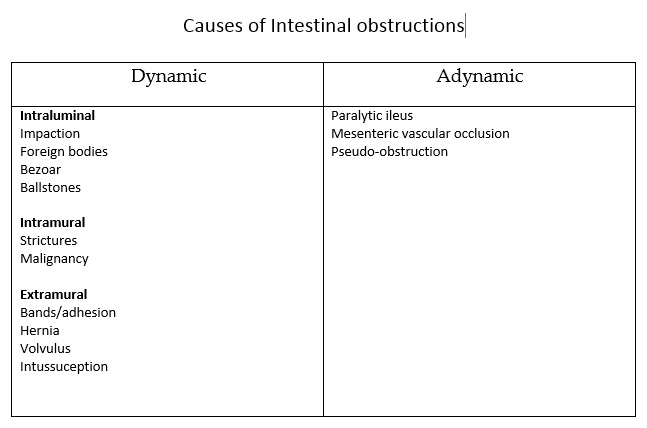Clinical Features
Abdominal pain
Sudden and severe, colicky,
Near umbilicus in small bowel obstn and in the lower abdomen in large bowel obtn
Later colicky pain becomes constant diffuse pain as the abdomen distends
Sever constant pain with rebound tenderness and toxicity indicates strangulation
Vomiting
The more distal the obstruction the more delayed the symptoms of nausea and vomiting
Initially digeted food later on faeculent
Abdominal distension
In colonic obstructions the distension is huge
In small intestine the distension is proportionate with the length of the intestine involved
Visible intestinal peristalsis may be present in the beginning
Constipation
Absolute constipation - neithter faeces nor gas is passed - cardinal feature
Relative constipation - flatus only is passed
Constipation may not be present in Richter's hernia, gallstone obstruction, mesenteric vascular obstruction, obstruction associated with a pelvic abscess, partial obstruction (faecal impaction/colonic neoplasm, where diarrhoea may often occur)
Dehydration : due to repeated vomiting and fluid sequestration into the intestinal lumen : dry skin and tongue, poor venous filling and sunken eyes with oliguria. The blood urea level and haematocrit rise.
Hypokalaemia
Pyrexia : indicating ischaemia, intestinal perforation, inflammation
Abdominal tenderness - indicating either establishe ischaemia/peritonism or infarction and perforation
Complications
Strangulation of intestine
Gangrene
Perforation
Peritonitis
Toxemia
Death
Medical Management
Naso gastric decompression
Correction of electrolyte and fluid imbalances
Correction of any prerenal uremia
Antibiotics
Surgical Management
Depending upon the cause of obstruction the surgical procedure differs :
Stricture of the intestine : resection and anastomosis
Tumour : rescetion and anastomosis or resection and an ostomy (temporary or permanent)
Inflammtory : (appendix) excision or resection and anatomosis
Intussuscption : reduction or if gangrenous resection and anastomosis
Nursing Management
Pre-operative
Patient is kept nil orally
Nasogastric suction done
Monitor abdominal girth every 4 hours
Monitor TPR, BP
Monitor bowel sounds
Monitor IV fluids and electrolytes
Assess hydration status
Prpare tha pt for sugery, pre-op instructions carried out including medications
Assess the patient's knowledge about diagnosis, prognosis, surgical procedure, appearance & care of the wound after surgery, dietary restrictions, pain control and medication management
If needed arrange for an enterosomal therapist
Provide emotional support
Provide privacy
Teach relaxation techniques
Provide time for the patient and family to ask questions
Arrange a person who is successfully managing a colostomy to talk to the patient
Post-operative
Provide wound care - frequent examination of the dressing during the first 24 hours
Teach patient to splint the abdominal incision during coughing and deep breathing
Monitor TPR
If a colostomy is present stoma examined
Check drainage appliances if present
Monitor Bowel Sounds
Look for any complications
Look for hemorrhage
Any change in abdominal, in the blood reports to be reported to the physician
Pulmonary complications have to be guarded against. (pneumonia, atelectases): changing sides, deep breathing, coughing, early ambulation have to be carried out
Teach ostomy management
Teach self care and educate the family
Mr.R, 38 years old is admitted to surgical ward with the history of indigestion and vomiting. State the causes and clinical manifestations of intestinal obstruction. Explain complications of intestinal obstruction. Discuss in detail medical, surgical and nursing management of Mr.R



